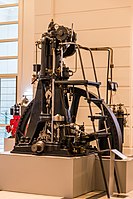
Photo from wikipedia
To improve the controllability for the evaporation process of fuel spray impinging on the cylinder wall, an experimental study on the development of morphological process of different fuel droplets on… Click to show full abstract
To improve the controllability for the evaporation process of fuel spray impinging on the cylinder wall, an experimental study on the development of morphological process of different fuel droplets on aluminium alloy surfaces is carried out. The metal surfaces with different wettability are prepared by laser etching and chemical etching for the experiments. In total, three different fuels are tested and compared under different surface temperatures, including diesel, n-butanol and dimethyl carbonate (DMC). The results show that under a lower wall temperature, the surface wettability, viscosity and surface tension of the fuels have significant effects on spreading and rebounding behaviour of the droplets. As the wall temperature rises over the boiling points of the fuel but below its Leidenfrost temperature, the contact angles between the fuels and surfaces are varying according to the surface wettability, boiling point and Leidenfrost temperature of the fuels. When the temperature of the surface exceeds the Leidenfrost temperature of all the fuels, after impacting the surfaces, different fuel droplets tend to have the same development pattern, regardless of the surface wettability. The rebound level is mainly affected by the amount of fuel vapour generated during the wall-hitting process. Viscosity, surface tension and other properties of the fuel have little effect on post-impacting behaviour of the droplet when the wall temperature is higher than the Leidenfrost temperature of the fuel.
Journal Title: Journal of Bionic Engineering
Year Published: 2020
Link to full text (if available)
Share on Social Media: Sign Up to like & get
recommendations!